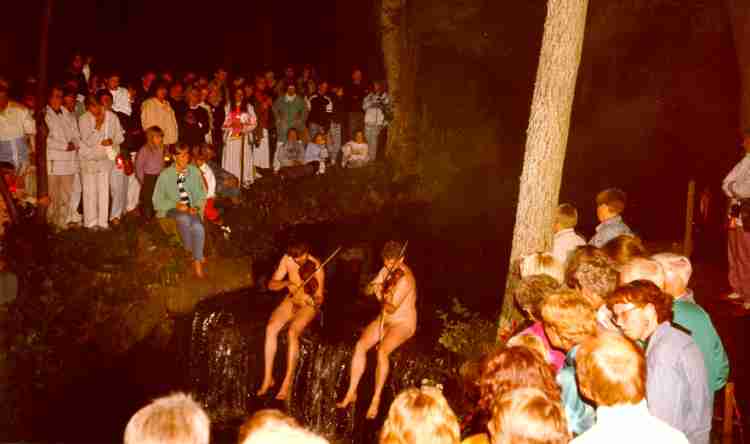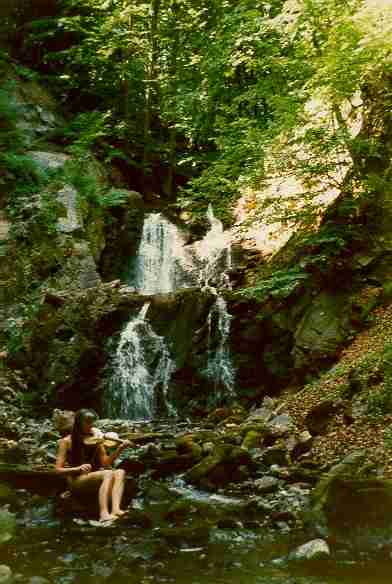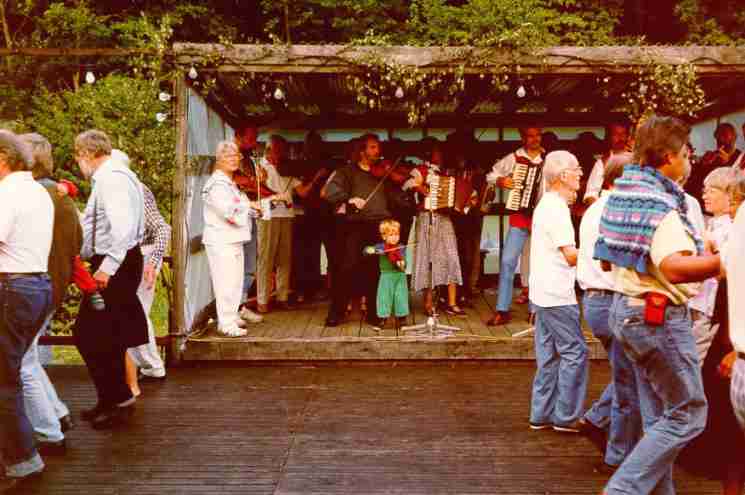Folk dance music with improvisations
Jänta å ja (The Girl and Me)
|
| Niels Mejlhede Jensen, Bøgeløvsvej 4, 2830 Virum, Denmark.
e-mail
(web master) |
Old tune used for folk dancing in Denmark 1999 arranged with improvisations
Link to index to other dances.
CONTENTS: (remember: you can use Ctrl Home in usual browsers
to get to the top of this page, to the links here)
-
Dance of the week 1999 date: Jänta å
ja (The Girl and Me), hambo dance
-
Dance description, will open on
a new page, in a new window, so that this window with music is kept behind
-
Music description (you stay on this page)
-
Performing proposals
(new page, in a new window, with this window behind)
-
Music scores for C, A , Bb, Eb, F, and bass
instruments (to text on this page)
-
(c1, c2),
(a1,
a2),
(b1, b2),
(e1,
e2),
(f1,
f2),
(bass1, bass2);
(note sheet will open on a new page, help here)

Photo 1 of this week: Midsummer in Scandinavia, so be careful
by the water streams: then näcken or nøkken will play his most
enchanting spelling music from the stream, which specially at night is
so fascinated compelling that you have to follow näcken down into
the stream, away form this everyday world, down into his enchanted underworld,
leaving your family here in sorrow over the loss of you. Unless you can
break the spell. I could only break my spell by concentrating on climbing
up and taking this picture. Because the two näckar, Åke and
Hasse, sitting in the (cold) water close to the water mill in Degeberga
in Scania (South Sweden) play the most wonderful underworld Swedish folk
music you can ever think of. Thank you to Åke and Hasse for many
such brave performances. This was absolutely top class folk music from
Sweden.
 |
Photo 2 of this week: Nøkken plays her enchanting music
in the stream somewhere out there in the Scandinavian nature.
If you are wandering in the unblemished nature, deep into the forest
away from the motorized civilization, out in the excited mystery with proximity
of fauns and elves and further back troll kids puzzling behind every boulder
and tree, and are you then lucky to come by also nøkken, then stop
up in quietude at some distance and enjoy the fantastic spell that will
catch your soul with this combination of folk music and the murmuring water
and forest orchestration in the lofty fresh nature. |

Photo 3 of this week: Dance in Sweden on "lövad dansbana",
= outdoor dance place decorated with green leaves. We (Fiddlers' Dance
from Copenhagen) play to a Danish line dance (dance
2), at a summer festival in Degeberga (in South Sweden).
A little story:
Algot, our oldest member of Spillemandsdansen (Fiddler's Dance) died a
week ago 93 years old. He played his fiddle in our band until 2 months
ago. Algot was just the nice common person like everybody else in our folk
dance, (those persons that folk dance is meant for). Algot was Swedish
Danish, as he was born and grew up in the region not far from Degeberga
in Sweden where the above photos are from. Algot's father was the local
tailor, and from him Algot learned the profession. But there was no tailor
job for Algot in east Scania, so he went west to Malmoe to look for a job
- and found employment in Copenhagen. Algot learned to play the fiddle
from the good local fiddler, who himself carefully wrote all the music
notes of the good old Swedish tunes that Algot had to learn. At Christmas
1998 Algot and his 96 years old fiddler friend in another band there played
their usual duets of old tunes. Algot was always a merry member of our
group, and he liked to greet the ladies with a kiss. We will miss him.
We will also miss Hasse (= Hans Melin) who died earlier this year 45
years old. We will miss his brave näcken play (see photo
1 above), and other even more courageous events, and we will
miss his organizing talent. Hans Melin was probably the most prominent
folk musician of South Sweden to day, and organized getting much public
attention and support to folk music and music in general.
Dance of the week, 1999, april 19:
Jänta å ja.
(English: "The Girl and Me").
Dance of couples, hambo.
Music and dance from Sweden. Traditionally the same music (with a Danish
title) would be played in Denmark as a mazurka.
The melody can be heard in midi on computer piano in my tempo (if you
have a sound card). (The melody will loop here until you stop it. In the
table below it will play once). (I have not played the tunes here with
the "drive" I want for dance music).
Music description:
The music notes are written as a score of 12 staves on one A3 page = two
A4 pages side by side (= an open A4 book).
Place the two note sheets side by side. Then staff 1 (= melody) on
the left page continues as staff 1 on the right page.
The 12 staves:
(The midi music is not repeated, except for 1' and 2' voltas).
Use also octave, up and down.
Where wanted, notes can be changed according to the principles (use
a colour pencil), e.g. to improve the B part with some notes from
A.
The music is aimed at dancing, so part of the orchestra can be the
underlying "motor" when another instrument group is playing its "solo"
part (improvisation) as one of the many repetitions.
The double bass may play its usual notes, because of its low pitch.
It is better to choose a more simple part and play it well.
Accordion: beats per bar: 1+1, on beat 1 and beat 3, nothing
on beat 2.
(It is not a waltz). It is important to have beat 3 (besides
beat 1) well marked. The melody introduces the marked beat 3 in bar 1 and
2 and the important marked beat 2 in every played 8th bar (end of phrase
1 and end of phrase 2).
I have made a ns part that should promote the marked beat 3, and with
tones of the same pitch on beat 1 and 2 to disable the waltz slur from
beat 1 to 2. Specially for not so experienced bands an accordion can be
a good "dance motor" in hambo etc. because of its left hand bass.
Music scores:
Each score consists of 2 pages: page left and page right. They are given
on separate pages with links on the top of this page (use Ctrl Home to
go to the top). The links are repeated here:
(c1, c2),
(a1,
a2),
(b1, b2),
(e1,
e2),
(f1,
f2),
(bass1, bass2)
When you click a link the music note sheet will (should) open as a
new page on top of this main page, so that you can easily return to this
main page. And you can easily open 2 windows of note pages to have both
the left and right page in smaller windows, the right below the left.
(Help coming back from that note
sheet: CLICK the note sheet to come back to this page, or just close
the note window.
Remember: the note sheet opens in a new separate window, and that may
cover the whole screen. The back button in the tools bar does probably
not work because the window is new, with no history. All you see on the
page are notes because I have placed no link back here for not disturbing
easy submitting to the printer. Close the note window with a click at the
top or with Alt F4, or minimize or reduce the window, or ..., and you are
back to the main page that was there behind all the time).
Bottom of this page.


